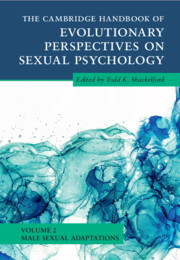Book contents
- The Cambridge Handbook of Evolutionary Perspectives on Sexual Psychology
- The Cambridge Handbook of Evolutionary Perspectives on Sexual Psychology
- Copyright page
- Contents
- Contributors
- Preface
- Part I Precopulatory Adaptations
- Part II Copulatory Adaptations
- 8 Sexual Fantasy
- 9 Ejaculation Latency
- 10 Copulatory Thrusting in Males
- 11 Men’s Provisioning of Oral Sex
- 12 Inducing Female Orgasm
- 13 Copulatory Urgency
- Part III Postcopulatory Adaptations
- Index
- References
9 - Ejaculation Latency
from Part II - Copulatory Adaptations
Published online by Cambridge University Press: 30 June 2022
- The Cambridge Handbook of Evolutionary Perspectives on Sexual Psychology
- The Cambridge Handbook of Evolutionary Perspectives on Sexual Psychology
- Copyright page
- Contents
- Contributors
- Preface
- Part I Precopulatory Adaptations
- Part II Copulatory Adaptations
- 8 Sexual Fantasy
- 9 Ejaculation Latency
- 10 Copulatory Thrusting in Males
- 11 Men’s Provisioning of Oral Sex
- 12 Inducing Female Orgasm
- 13 Copulatory Urgency
- Part III Postcopulatory Adaptations
- Index
- References
Summary
Ejaculation latency is the time from penile intromission to ejaculation. This chapter does not pretend to exhaustively cover all aspects related to this parameter of copulatory behavior, but selectively reviews anatomical, intrinsic, and environmental factors involved in its regulation, mainly in laboratory rats and in humans. Except in humans, short ejaculation latencies denote high sexual performance, most likely because of the high biological value of ejaculation: reproduction. Ejaculation, however, not only refers to a characteristic motor copulatory pattern, but also to seminal emission. The first part of the chapter reviews the anatomical substrate of the sexual function of ejaculation that comprises two phases: emission and expulsion. The neural control of these two phenomena are described and its peripheral and central (i.e. spinal cord and brain) components are addressed. In the second part of the chapter we review copulatory diversity, considering noncopulating and copulating males. Regarding the former, we discuss interesting mechanistic suggestions: low aromatization of testosterone to estradiol in the medial preoptic area and decreased endocannabinoid transmission. In a following section we address previous ideas that within a large male population of rats there are males with short, intermediate, and long ejaculation latencies. The distribution we found was more similar to that observed in humans: a large number of males with short ejaculation latencies. The characteristic patterns of short, intermediate, and long ejaculation latencies may vary with training experience or may be fixed. Finally, we present an example of how ejaculation latency and sperm count vary with male behavioral phenotype, competition with another male, and female regulation of the timing of copulation. This research indicates that males with short ejaculation latencies are more affected by competition and by the female regulation of the timing of copulation.
Keywords
- Type
- Chapter
- Information
- Publisher: Cambridge University PressPrint publication year: 2022



